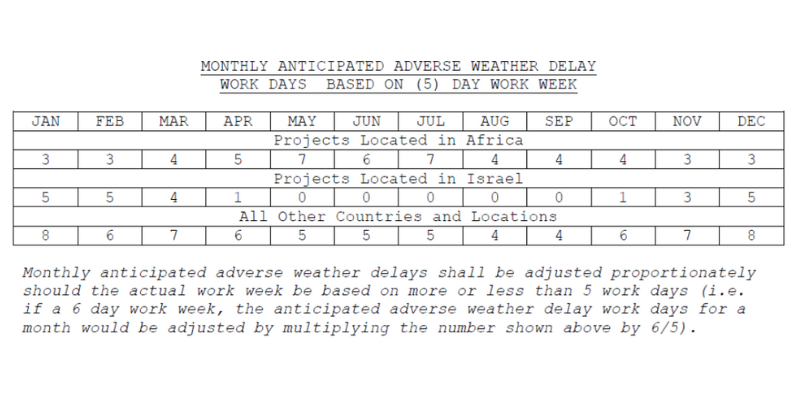Construction is fraught with many different risks; some controllable and some not. Mother Nature is one uncontrollable risk that can have a significant impact on a project. Contractors and Owners need to determine how weather is contemplated under the contract and modeled in the schedule, as resolution of weather delays can cast a dark cloud over a project if disputes arise. This blog post discusses ways that weather can be modeled in a schedule.
Determining how many weather days are appropriate.
The first step for considering weather in a construction schedule is understanding the project characteristics – where the project is located and when the work will be performed. Projects in Kittery, Maine are going to have different weather conditions than those located in Los Angeles, California, or Riyadh, Saudi Arabia.
The contract should be reviewed to determine if (1) a designated number of weather days are specified, or (2) if a procedure for implementing considerations for weather is specified. Some agencies may have general guidance, as shown in the figure below, while other contracts may be project specific.

The general intent is for the schedule to model normally anticipatable weather impacts to establish appropriate durations and to set a metric for potential excusable time extensions when adverse weather beyond normal conditions is encountered.
When a pre-determined number of anticipated weather days is not provided, contractors may rely on their own personal experience, or more appropriately, historical weather data. In some instances, the contract may specify a timeframe to utilize for historical data to generate the number of anticipated weather days per month. Historical weather data can be accessed from databases, such as the National Oceanic and Atmospheric Administration’s (NOAA) Climate Data Online portal. U.S. Army Corps of Engineers guidance for time extensions for weather recommends, when possible, to use the last 10 years of consecutive data.1
Special consideration must also be provided for the type of work being performed. As certain activities – for example, asphalt paving – may be subject to temperature or moisture restrictions – different calendars may be required to contemplate conditions beyond the “normal” anticipated adverse weather.
Incorporating Weather in the Construction Schedule
Weather days can be incorporated into a schedule in a variety of ways, each with its own pros and cons. While other methods can be used, three potential ways of incorporating weather are (1) applying non-workdays to the work calendar(s); (2) incorporating anticipated weather within activity durations; or (3) utilizing a weather day activity. These methods are discussed below.
- Calendar non-workdays
CPM scheduling software allows the application of calendars to activities. These calendars establish the number of workdays per month. Calendars should represent known non-work days (such as holidays or weekends), as well as anticipated non-work days. The project can be on a global calendar, or can have multiple calendars dependent on the activity. For example, when the contract specifications provide non-work periods or restrictions, these can be modeled using calendars. For example, if the specifications do not permit water main work between December through March, or only allow for landscaping to be performed during a designated planting season, calendars can be assigned for associated activities that will ensure the schedule network is modeled and calculated with these considerations.
Since adverse weather can happen on any given day, one method for incorporating weather into a schedule is to distribute the anticipated number of adverse weather days throughout the calendar as non-work days. The figure below shows a calendar where October 7, 10, 19, and 27 were assigned as non-work days. When the CPM software schedules the work using the established durations and logic, it will apply the non-work days from the calendar(s) as part of its computation.

When using this strategy, it is important to model the calendars beyond just the original completion date, so that if delays are encountered during the project, the calendars can still appropriately model weather. Consideration should be given to activities that are appropriate to include on weather calendars – for example, in vertical construction, adverse weather would not typically affect interior activities after building enclosure is achieved. If weather is required to be tracked monthly, maintaining a weather log in the monthly schedule update narrative is a useful tool for providing transparency of anticipated weather versus actual weather.
This method of applying non-work days into the schedule calendar(s) affords for more dynamic modeling of forecast performance, since if activities shift earlier or later, the anticipated non-work days will apply to when the work is expected to be performed. While this method of distributing non-work days in the calendar provides insight into what was contemplated by the contractor, it can present some challenges for retrospective forensic schedule analysis, as multiple calendars can impact float calculations and activity criticality. It may also create confusion if parties are not familiar with the applied calendars, since an activity have a relatively short duration, but appear to start and finish over a much larger duration if calendars are restricting the available workdays.
- Weather as part of activity durations
In some schedules, non-work weather days are not discretely identified but co-mingled in the planned duration of the activities. Since contractors often use historical production data to estimate durations, historical durations would be expected to inherently include weather data. Such considerations may backfire if working in a region or time of year different than the data source, or adjustment factors may need to be considered.
The schedule durations can also be estimated based on typical productivity (without weather considerations) and refined based on review of the draft baseline schedule. For example, if steel erection in normal weather would be expected to be performed in a 10-workday duration, this duration can be increased to account for potential weather impacts, particularly with consideration for when the work is expected to be performed. This method does pose the problem of not adapting to changes to the work plan. For example, if durations were not adjusted for activities that were expected to be performed, but were delayed into the winter, the schedule would not model the likely weather issues to be encountered. Without accompanying documentation on assumptions, this method does not provide transparency as to what “normal” adverse weather was considered, and may result in additional scrutiny if time extensions are requested.
- Weather day activity
Another option is to include a “Weather Days” activity in the schedule as a predecessor to substantial completion, as shown in the example below.

The “Weather Days” activity duration would be set to the anticipated number of weather days, and the duration of physical work activities required for completion will not contemplate weather.
Thus, except for holidays or other non-work days modeled in the schedule, this method does not anticipate adverse weather on a given day and assumes work will be performed every day. For short-term planning using the schedule, dates are presented without consideration for random weather. The benefit of this technique is that as weather days impact the Project, the remaining duration of the “Weather Days” activity can be reduced, tracking the impact. This method also helps simplify schedule network calculations, which may make a retrospective delay analysis simpler if randomly applied non-work days do not need to be considered in schedule calculations.
A shortcoming of this method is that it may be less useful for longer-term planning. For example, if just-in-time delivery is required for materials or equipment, this schedule would be expected to forecast dates that may be earlier than reality, since all non-work weather dates are captured at the end of the schedule network. Similarly, longer-term coordination with subcontractors may be inaccurate.
Other strategies also exist, such as adding weather day activities into the planned sequences or work breakdown structures. This could be an effective strategy for certain portions of the project – for example, concrete superstructure, where a weather day activity is added at the end of the chain of activities, or intermittent throughout the network.
There is no universally accepted way of considering weather in construction schedules. The requirements of the contract should always be reviewed to ensure schedules are compliant. When the contract is silent, a method should be used that is comfortable to the party or parties preparing the schedule and within the expertise of the scheduler.
With respect to ensuring equitable adjustments to the contract duration for time extensions for weather, establishing the parameters for modeling and measuring weather days early can simplify the process and reduce the potential for dispute.
How Can VERTEX Help
Managing weather impacts in construction schedules is crucial for minimizing risks and avoiding disputes. At VERTEX, our experts specialize in this type of work, ensuring your projects stay on track despite weather-related challenges. To learn more about VERTEX’s Forensic services or to speak with an Expert, call 888.298.5162 or submit an inquiry.




